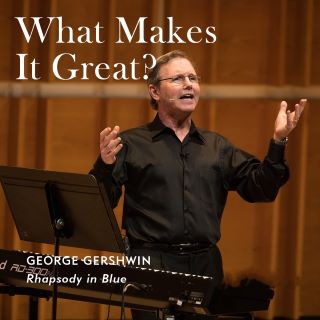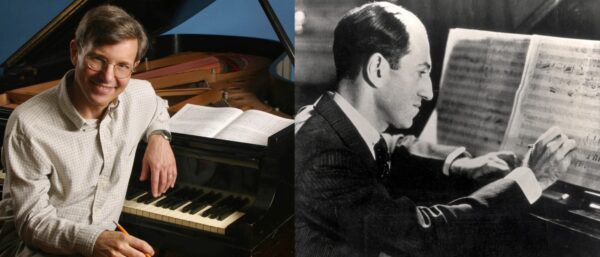YES, IT WAS GREAT!
Celebrity music educator Rob Kapilow – joined by virtuosic pianist Clayton Stephenson and members of the Berklee Contemporary Symphony Orchestra conducted by Julius P. Williams – provided an enlightening and entertaining evening of musical analysis and performance last Friday night at New England Conservatory’s Jordan Hall.
Assisted by Stephenson and orchestra members (most notably perhaps, Nolan McCullough, who repeatedly performed the haunting opening clarinet glissando), Kapilow offered a fascinating account of the history of the composition and arrangement of George Gershwin’s Rhapsody in Blue. Gershwin claimed that the basic form of the work came to him while on a train from New York to Boston in January 1924. Its first public performance, by Paul Whiteman’s band, was only a few weeks later, at the “Experiment in Modern Music” concert in New York’s Aeolian Hall. Last night’s performance on the centennial of the work’s composition and first performance seemed especially appropriate.
It’s certainly easy to hear the influence of the train’s rhythm in the piece. Much of what makes it so appealing (according to Kapilow, while there were some early negative reviews of the piece, it was popular with audiences from the very beginning) is the juxtaposition of that rhythm with the blues scale, the syncopated swing tempo, and the evocation of a Hollywood score. Whiteman’s arranger, Ferde Grofé (The Grand Canyon Suite) orchestrated the composition for that 1924 performance by Whiteman’s 23-piece band, which included a banjo, a variety of mutes, and a snare drum hit by a fly swatter! Grofé rearranged Rhapsody in 1926 and then again in 1942, this time for a full symphony orchestra. Other arrangements were created to accommodate the era’s recording technology – cuts were made in 1927 so the piece could fit on a 12-inch record, for example.
The main difference in these arrangements (other than the size of and composition of the orchestras involved) was that in the earliest arrangement, the orchestra carried the classical line of the composition while the piano carried the jazz. This is an arrangement rarely heard today, because this relationship was flipped in subsequent orchestrations, but it was the one we were privileged to hear last night, Stephenson (presently pursuing his BA at Harvard and his MA at NEC and surely a career to watch) repeatedly wowed the audience with his supple fingering and cross-handed delivery of the torrent of notes that give Gershwin’s composition its driving and exhilarating energy.
By the time we heard the full performance of the piece, Kapilow had walked the audience through the composition to help us recognize echoes of other familiar Gershwin compositions such as “The Man I Love” and “I Got Rhythm” in the repetition of the three notes up/three notes down patterns that are found throughout the Rhapsody. Kapilow is a dynamic educator. While he occasionally enlisted audience participation in singing brief melodic phrases, he was even more effective in drawing on the talents and energies of the young musicians in the Berklee orchestra, who illustrated many of his points with humor and passion.
But Kapilow had a message that went beyond the structure of this particular composition. Much of the controversy about Rhapsody in Blue, he commented, has to do with how it is labeled. Is it jazz? Is it classical? He urged the audience to resist the limitations of labels, quoting alternative medicine practitioner Rachel Naomi Remen in saying that a label creates expectations that give us “a false sense of familiarity toward something that is new and unprecedented.” Offering a quotation that he attributed to Carl Jung, Kapilow added that “the privilege of a lifetime is being who you truly are.”
Rob Kapilow: What Makes It Great?
George Gershwin’s Rhapsody in Blue
Celebrity Series of Boston
New England Conservatory’s Jordan Hall, 50 Gainsborough St. in Boston
reviewed on December 6, 2024
for What Makes It Great? tour dates and cities, visit Rob Kapilow


